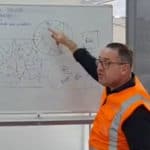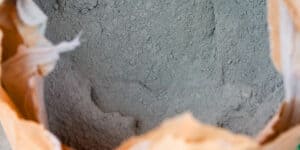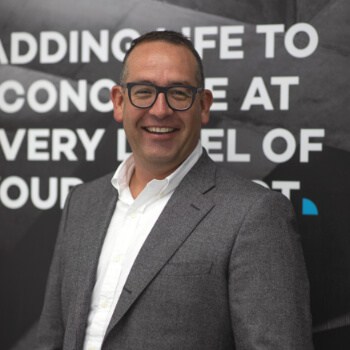Don’t tell Mark! From a sneaky fly-on-the-wall viewpoint, we’re sharing snippets from one of our training sessions. Mark Smith, CEO of MARKHAM, digs into the science of concrete curing, the inherent weaknesses that result, and how AQURON can help. With a passing mention of skin cancer, and the discolouration of concrete traffic barriers in Auckland! Concrete embalming, anyone?
AQURON Insider

Invisible Strength
AQURON Insider
/
RSS Feed
AQURON Insider
Concrete durability: markhamglobal.com/solutions/concrete-durability-treatments
Chemical contamination: markhamglobal.com/concrete-and-agricultural-chemicals
View the Transcript
BRENDAN: G’day everyone, and thanks for listening in on MARKHAM’s latest Invisible Strength podcast session! I’m Brendan Stead, Marketing Coordinator, and today we’re having a sneaky fly-on-the-wall listen, to Mark Smith, our CEO training Doug, one of our applicators.
Mark is talking Doug through the science of concrete, and how AQURON hydrogels help. Without further ado, here we go!
_ _ _ _ _
MARK: So Doug, we’re going to take a trip inside the concrete a little bit further deep down. So these are the aggregates. This is the sand. There’s the cement. Here’s your moisture and that’s the moisture particles forming together to make a porosity to escape. So that’s right at the very beginning. So what happens after that? The aggregates don’t change. The sands don’t change. The actual cement reacts with the moisture that’s in the mix, then starts forming polymer strands. And each little cement particle forms these strands. And it’s not known exactly … it’s not like each one can have an infinite amount of strands, it’s not … So they’re all interconnected.
That’s why they call it cement. Those parts there are actually calcium silicate hydrate, which starts as cement reacting with water. They are the binder that holds the concrete together.
DOUG: So they are the strength.
MARK: They are the strength of concrete.
So what happens is these, in the early stage when there’s no porosity, come through and they’re all interconnected. Now bear in mind, these are only hours old. So this is like, in a simile, getting a strong rugby player, as in the water particle, running through a whole lot of kids; it breaks their bond. So, therefore, that’s why you get … the more moisture you have in the concrete, you weaken the concrete. So that’s why people are always trying to provide concrete that has to have a certain amount for workability, but also they don’t want too much so that you get weak concrete. But at the end of the day, the porosities happen.
So that is concrete; nothing to do with AQURON. We’ll then talk next about what AQURON does when it comes into the concrete.
So Doug, up until now what I’ve talked about is concrete, we haven’t even talked about AQURON. But if we come back to thinking of AQURON as colloidal silica, having nanoparticles, with the unique catalyst to makes it penetrate into the concrete. It forms a calcium silicate hydrate – remembering that the actual polymers that come out of a cement particle are calcium silicate hydrate. That’s why we say it’s compatible with anything that’s compatible with concrete. And it transports away moisture that’s held in concrete.
So that even after the bleed water has gone, there is still parts of moisture left in the concrete. And that is what we call it relative humidity. So part of the moisture has been used up by the cement; part of the moisture has gone out as the bleed water, gone, and then there’s a residual amount of moisture in there that varies between every mix, and they referred to as relative humidity. That relative humidity is really good for curing. And it’s really bad for floor coverings. So on one hand you wanted it good for curing. On the other hand, for floor coverings, you just don’t want it to move. That’s the main thing.
Okay, so you come along and add AQURON. AQURON works in the porosities. We are not a surface coating. So that why you ‘read’ the concrete when you’re applying it, okay? And we would expect the Aquron to go down and penetrate into the concrete in the porosities. That doesn’t change the aggregate. It doesn’t change the cement, it doesn’t change the actual sands. It only works in the porosities. You know what? It doesn’t even change the surface. So surface traction or surface, sealing of the surface actually doesn’t look any different when treated or untreated. So you’ve got this all the way through the concrete.
Now what happens is that AQURON comes down and it starts forming calcium silicate hydrate by reacting with the alkalinity and that moisture. And it forms calcium silicate hydrate across the pores, so therefore the moisture can no longer move through the porosity of concrete.
_ _ _ _ _
Doug – people wonder – carbonation; … ASR and DEF are all kind of a bit of a … they’re a bit of a specialist area, like you’re talking bridges and infrastructure. The rest of the time, for most standard construction you don’t even talk about it. But carbonation; you know when you go along the Auckland motorway and you see a new concrete barrier…
DOUG: Yes.
MARK: And then a few months later you go past and then your new concrete barrier has started to go black.
DOUG: Similar to the ones at Sylvia Park.
MARK: Started to go black along… So what it is if you actually got out and touch those, they’ve actually been etched. It’s not just soot. There is some soot. But what it is, is the carbon monoxide is landing on the surface, then the moisture is, ending together, as mixing and creating an acid.
Carbon dioxide and carbon monoxide, and water, there’s an acid. What breaks down concrete is an acidic environment. Concrete is alkaline. What will break down alkalinity is acid. So that constant moisture.
So how does their chronic defeat carbonation? It can’t adjust it from the surface, but what it does do is it stops the carbonation going and all through the veins of the concrete. So what I would say is, for carbonation in an acidic environment. What you would see in one year on an untreated concrete would be similar to three years on an “embalmed” or Aquron-treated concrete. So that means we’re times-ing the durability by at least three times.
Does that make sense?
DOUG: Yep!
_ _ _ _ _
MARK: What I’m not saying, Doug, is that if you have skin cancer, that if you’re not going to do anything about it, it will never get to your bones. We all know that skin cancer ends up going along and affecting other parts of your body. So in the same way ASR is effectively only starting on the surface, at the very top surface, then it gets more and more and more. But the problem is if it goes untreated, without fail it will go to the point that the reinforcing steel will rust out.
So I’m really concerned that people are not doing anything about ASR when they should be. And the other part is, Doug, they think they’re doing something about ASR by putting on a hydrophobic topical coating. It’s absolutely stupid. The fact of the matter is, is that concrete still sweats behind that, just like you as a human sweat in a raincoat on a rainy day. A concrete structure with a raincoat on it sweats inside. So therefore the ASR condition just keeps on going. You haven’t done anything. In fact, you may have even made it worse.
So what I’m hoping is that industry professionals start thinking about ASR from an early detection point of view. And you only need to talk to people like Dr Jon Belkowitz, who will actually tell you – this is a problem that people… it hasn’t dawned on them as how serious it actually is. So yet, in my lifetime I hope to see that there’s a change in thinking about how people treat ASR. DEF is along the same hypothetical line, and carbonation, all those things. Basically go back and think, Stop the moisture transmission, create a constant within the concrete, and you’ll have no further ASR problem. So yeah, I’d like to really be able to help people that are in those early stages.
So what is MARKHAM doing? We are saving the world one concrete structure at a time!
_ _ _ _ _
BRENDAN: And that’s it! Thanks all. If you want to get in touch, visit our website www.markhamglobal.com
We’re keen to get your feedback, or suggestions for future topics. Have a great day, and don’t miss our next episode!
Want to Contribute?
Feedback on our podcasts? Suggestions for future topics? Looking for more information on topics we’ve discussed? Send us a message – we’ll be in touch within a day or two.
More about MARKHAM
MARKHAM are dedicated to providing innovations for concrete and construction. Focusing on concrete waterproofing solutions, penetrating concrete sealers and durability treatments for concrete.
Podcast Categories
Latest Episodes

The Electric Vehicle of Cement Making
We’ve talked about this in other places, but cement manufacturing is a real problem child

Starting Good Conversations
Have you seen those colourful Trademutt shirts on site? They’re a conversation starter! This is

Lessons in Infrastructure Remediation
In this very practical segment, Mike shares pointers from his past experience in infrastructure remediation.
invisible strength podcast
The whole MARKHAM team is pleased to present you with our podcast series, INVISIBLE STRENGTH. In this series of interviews, we’ll walk through the science and challenges of concrete durability, what goes wrong in the field – and the advanced methods available to restore and enhance service life to concrete construction.
INVISIBLE STRENGTH reflects a number of factors in concrete construction and durability. When things go wrong, the evidence can become very visible indeed. However, when all is going well, there’s nothing particular to be seen!
MARKHAM’s concrete treatments, too, are invisible once completed – and the result is the long internal, invisible durability of the concrete.
So join us as we explore the unseen world inside concrete – why it matters, and how it can be protected!
Stay Connected
Listen and subscribe to us on your favourite podcast platform, we're always adding new episodes!
Invisible Strength – The media site for MARKHAM – Adding Life to Concrete.
At MARKHAM, we’re on a mission to transform concrete and construction. Our Purpose? ADDING LIFE TO CONCRETE.
From innovative waterproofing solutions to penetrating hardeners and sealers, our focus is clear: to reinforce concrete structures and make them withstand the test of time.
Newsletter
Sign up for email updates on the latest collections, campaigns and videos.

